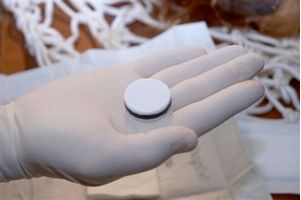"Over the years, we have been actively releasing a small number of orangutans back into the
forest, however we have had no way of monitoring them after release," explained SWD Director Laurentius Ambu in a statement. Placing a radio-tracking collar on orangutans has proven unworkable, because the great apes quickly learned how to take off the collars.
The three orangutans with transmitters are doing just fine, according to SWD Chief Field Veterinarian, Dr. Senthilvel Nathan.
 The transmitter implanted into the orang-utans are 35 millimeters in diameter and 10 millimeters wide. |
Prior to the transmitters being inserted into rehabilitated orangutans, they were tested on captive apes.
"Before coming to Sabah, Dr. [Christain] Waltzer and Dr. [Thierry] Petit tested this method on captive orangutans in France on the 18th of March this year to see whether it had any harmful effects to the orangutan," explained Laurentius. "Following their success in France, my Department then proceeded with their assistance to implant three orangutans in Sepilok late September."
Laurentius said that the safety and welfare of the animals implanted with the transmitters was the most important factor.
Thousands of orangutans are in rehabilitation centers. Many of these apes were orphaned after their mothers were killed by palm oil plantation workers or loggers as pests. Large-scale deforestation and human-started fires can lead starving orangutans into palm oil plantations for food. In addition, orangutans are often captured for the illegal pet trade.
Bornean orangutans are classified as Endangered by the IUCN Red List, while Sumatran orangutans are considered Critically Endangered. Both species' populations are on the decline.
Source
No comments:
Post a Comment